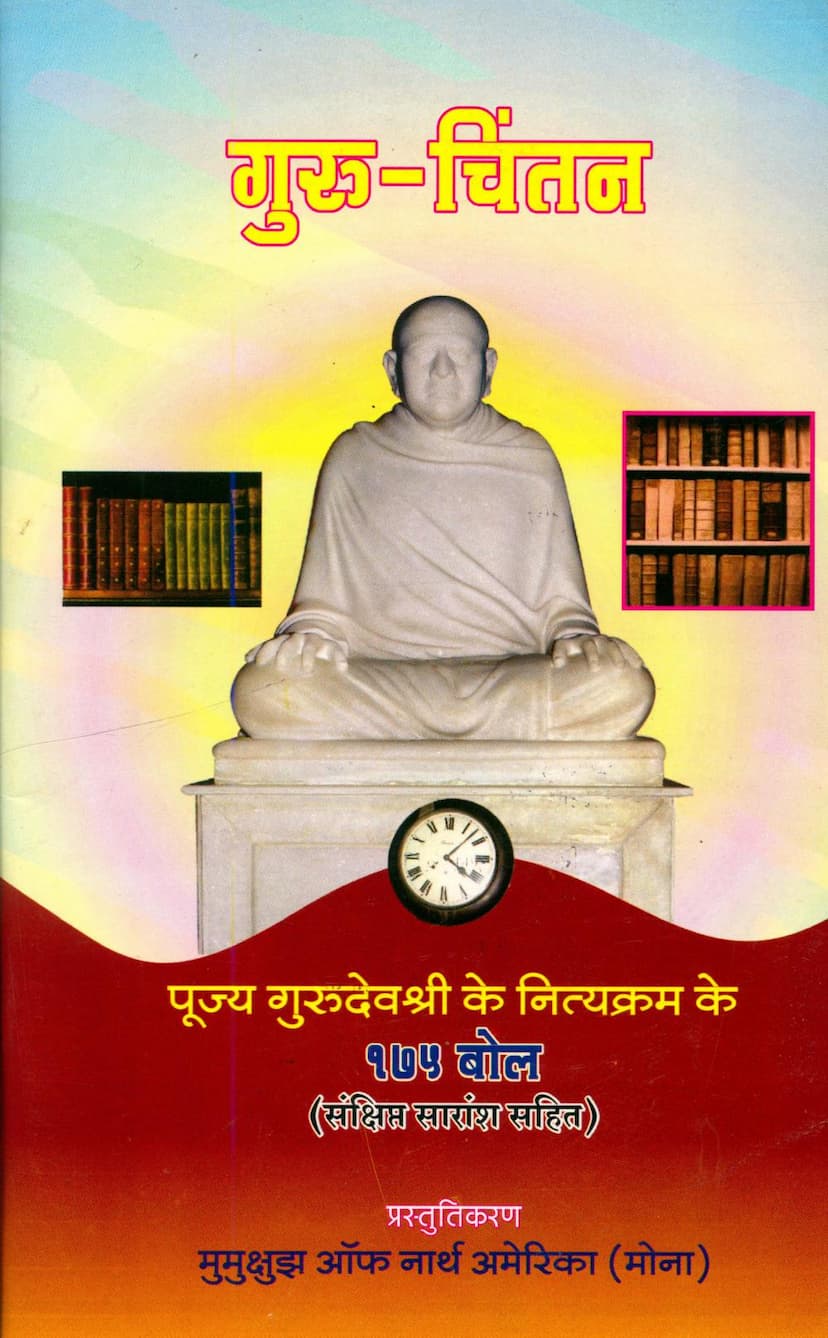Guru Chintan
Added to library: September 1, 2025

Summary
Here is a comprehensive summary of the Jain text "Guru Chintan":
Book Title: Guru Chintan (Guru Reflection/Meditation) Author(s): Mumukshuz of North America (MONA) Publisher: Mumukshuz of North America
Overview: "Guru Chintan" is a booklet presented by Mumukshuz of North America (MONA), dedicated to the teachings and daily practices of the revered spiritual guide, Pujya Gurudevshri Kanji Swami. The core of this publication is a compilation of 175 Bols (utterances/statements) that Gurudevshri would regularly contemplate and study. The book aims to make these profound teachings accessible to a wider audience of seekers, particularly those residing outside of India, by providing concise summaries written by scholars. It also emphasizes the importance of incorporating these Bols into one's daily spiritual routine.
Key Contents and Themes:
-
Invocation and Dedication: The book begins with prayers and salutations to the Tirthankaras, Acharyas like Kundkund, and specifically to Pujya Gurudevshri Kanji Swami and Pujya Behenshri, recognizing them as the current torchbearers of the path to eternal happiness as laid down by the Jinas.
-
The 175 Bols: The central theme is the contemplation of 175 Bols that formed Pujya Gurudevshri Kanji Swami's daily spiritual practice. The publication presents a summary of these Bols, indicating their significance in understanding the core principles of Jain philosophy.
-
Structure of the Content: The booklet is structured to provide a comprehensive understanding of the foundational Jain texts and concepts, as contemplated by Gurudevshri. The table of contents reveals the following sections:
- Shri Samaysarji Gatha 1 to 16: A detailed exposition of the initial verses of the Samaysar, a foundational scripture by Acharya Kundkund.
- Concise Summary of Shri Samaysarji Gatha 1 to 16: A simplified explanation of these key verses.
- Shri Samaysarji - 47 Shaktis (Powers): An explanation of the 47 inherent powers of the soul as described in the Samaysar, particularly in the 'Atmakhyati' commentary by Acharya Amritchandrasuri.
- Shri Pravachansarji - 47 Nay (Perspectives): An exploration of the 47 different logical or philosophical viewpoints (nay) used to understand reality, as discussed in relation to the Pravachansar.
- Shri Pravachansarji - 20 Bols of Alinggrahan (Indescribable/Incomprehensible): A focus on 20 specific statements related to the indescribable nature of the soul, meaning it cannot be apprehended through the senses or external means.
- Shri Samaysarji - 6 Bols of Avyakta (Unmanifest): A study of 6 profound statements that describe the soul as "unmanifest" or "hidden," even though it is inherently present.
- Shrimad Rajchandraji's 10 Bols on Self and Other Substances: A summary of the teachings of Shrimad Rajchandraji on distinguishing between the soul (self-substance) and other substances.
- Choubis Tirthankar Stavan: A devotional hymn praising the 24 Tirthankaras.
- Panch-Balayti Vandana: Salutations to the five "Balaytis" (young ascetics or vows).
-
Core Jain Philosophical Concepts Explained:
- Nays (Perspectives): The extensive discussion on Nays highlights the multifaceted nature of reality and how different Nays are essential for a complete understanding. It explains concepts like Dravya-Naya (substance perspective), Paryaya-Naya (mode perspective), Nitya-Anitya (eternal/impermanent), Astiva-Nasti (existence/non-existence), Vyavahar-Naya (conventional truth), and Nishchay-Naya (ultimate truth).
- Shaktis (Powers of the Soul): The 47 Shaktis section delves into the inherent capabilities of the soul, such as Jivatva Shakti (power of being alive), Chiti Shakti (consciousness power), Drishti Shakti (power of perception), Jnana Shakti (power of knowledge), Sukha Shakti (power of bliss), Virya Shakti (power of energy), and many others, illustrating the soul's multifaceted potential.
- The Soul's Nature (Avyakta/Alinggrahan): The sections on Alinggrahan and Avyakta emphasize that the true nature of the soul is beyond sensory perception, inference, or external description. It is inherently self-known and indescribable by ordinary means. The soul is described as distinct from external substances, karmic influences, and even its own transient modifications.
- Distinguishing Self and Other: The teachings of Shrimad Rajchandraji highlight the critical need to differentiate the self (soul) from all other substances (matter, karmas, etc.) through correct knowledge, faith, and perception, and to practice detachment from the latter.
-
Objective and Vision of MONA:
- Dissemination of Knowledge: MONA's primary goal is to spread the "Kundkund-Kahan Tatvagyan" (philosophy of Kundkund and Kanji Swami) across the globe, particularly to North America and beyond.
- Unity of Seekers: They aim to create an "Akhil Vishwa Mumukshu Parivar" (Universal Family of Seekers) to foster unity and collaborative efforts in spreading these teachings.
- Modern Technology: MONA utilizes modern technology (internet, email) to connect with and serve the global Jain community.
- Educational Initiatives: They are involved in adult, young adult, and children's education, organizing camps, seminars, and celebrations. They are also collaborating with universities to offer Jain philosophy courses.
-
Message and Call to Action: The publication encourages all seekers to understand these 175 Bols thoroughly, to firmly decide on the true nature of the soul (the 'trikali dhruv bhagvan atma'), and to strive for its direct experience as quickly as possible.
Significance: "Guru Chintan" serves as a valuable guide for anyone seeking a deeper understanding of Jainism as expounded by Pujya Gurudevshri Kanji Swami. It provides a structured approach to studying complex philosophical concepts, making them more digestible and applicable to daily spiritual practice. The compilation reflects the profound wisdom of the scriptures and the practical guidance of a revered spiritual master, aiming to uplift and unite the global Jain community in their pursuit of liberation.